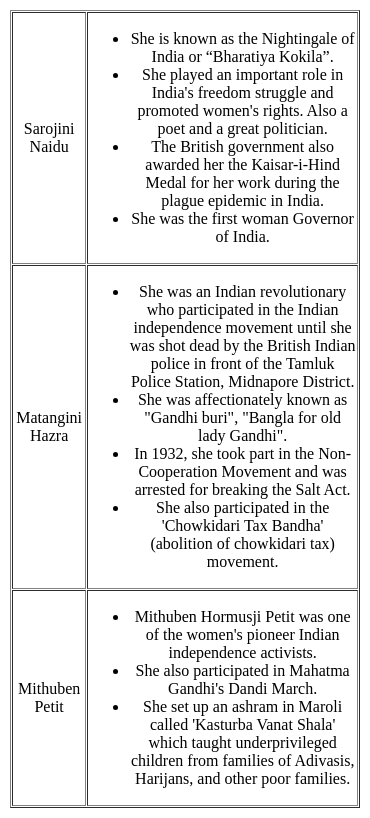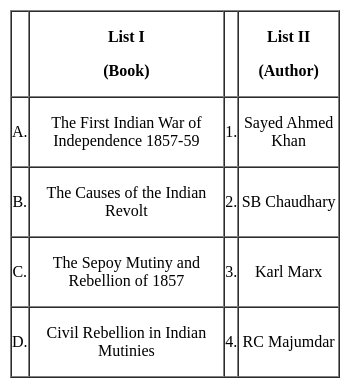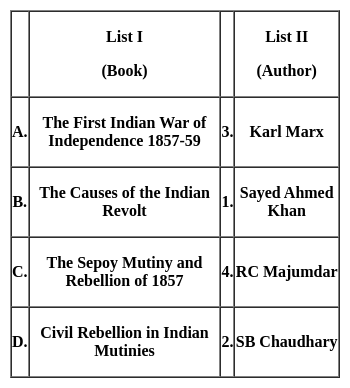UGC NET Paper 2 History Mock Test - 9 - UGC NET MCQ
30 Questions MCQ Test UGC NET Mock Test Series - UGC NET Paper 2 History Mock Test - 9
Abdur Razzaq, was greatly impressed by the unique features of Vijayanaga's fortification.
Choose the features of Vijayanagara's fort :
(1) Eight lines of forts were constructed
(2) No mortar was used in construction
(3) The stone blocks were wedge shaped
(4) Circular bastions and pyramids were there in forts
(5) The fortification did not enclose agricultural tracts
Choose the correct answer from the options given below :
Which of the following statement is/are correct?
- Jahandar Shah II encouraged Jazia System.
- Nadir Shah of Persia invaded with the help of Sadat Khan who defeated the Mughal army at the Battle of Buxar.
- Marathas under Baji Rao, for the first in Mughal history, raided in Delhi.
Select the correct code from below.
According to August Comte, the influence of 'Positivism' on Historiography is:
The Journal Bahishkrit Bharat was started by
Consider the following statements with reference to the Gupta period.
1. Parnadatta was appointed the Provincial governor of Saurashtra by Rudradaman.
2. The Vallabhi era is identical with the Harsha era.
3. Chandragupta Maurya called himself ‘Lichchavi-dauhitra’.
4. Manusmriti is regarded as the official law book of the Guptas.
Which of the above statements is/are not correct?Which act was passed by Lord Canning's government in 1856 to prevent any kind of resistance from the sepoys against their deployment abroad?
During the Indian Freedom Struggle, who among the following proposed that Swaraj should be defined as complete independence free from all foreign control?
After the Battle of Wandiwash, which ended on 22 January 1760, the English learnt some of the valuable lessons about the country and its its countrymen. With reference Choose the incorrect statements.
Consider the following statements.
1) The Chalcolithic people were very well acquainted with the burnt bricks.
2) Almost all chalcolithic communities used wheel turned black-and-red pots.
Choose the correct statements.
Consider the following statements about the Indian Council of Historical Research:
1. The Indian Council of Historical Research (ICHR) was established under the promulgation of the Societies Registration Act in 1972.
2. It is an autonomous organization, which draws funds from the University Grants Commission.
3. It does not provide fellowships and financial assistance to scholars and historians for their research.
Which of the above-given statements are correct?
Consider the following statements regarding Butler Committee:
1. The Butler Committee was set up to examine the nature of the relationship between the princely states and government.
2. Butler commission recommended that States should be handed over to an Indian Government in British India
Which of the statements given above is/are correct?With reference to Deccan Riots consider the following statements:
1. Here money lenders were mostly outsiders - Marwaris or Gujaratis.
2. Modern Nationalist Intelligentsia of Maharashtra opposed the peasants' cause due to the violence.
Which of the above statements is/are correct?
At the time of gaining independence, the President of ‘Indian National Congress’ was-
Which among the following emperors introduced the two laws of Vyavahar Samta and Danda Samata?
Which of the following statements about Ellora caves is correct?
- They were initially built by Saatavahanas.
- These caves belong to 6th to 10th century A.D.
- Unlike Ajanta caves, these caves are dedicated to only one religion, i.e., Buddhism.
Select the correct answer using the codes given below:
Consider the following pairs with respect to Indian Paintings:
- Chitra Sutra: Oldest known treatise on painting
- Jogimara Cave Paintings: Pre-Buddha paintings
Which of the pairs given above is/are matched correctly?
Nimar festival is organized every year in Madhya Pradesh at-
By which of the following for the first time, British government recognized the “Right of Dominion” for India?
The Indian Universities Act was passed in which year?
|
92 docs|125 tests
|

























